
Wyldes Farm is a Grade II* listed former farmhouse in the hamlet of North End, Hampstead, in the London Borough of Barnet (right on the boundary with Camden), NW11. [1]

Wyldes Farm is a Grade II* listed former farmhouse in the hamlet of North End, Hampstead, in the London Borough of Barnet (right on the boundary with Camden), NW11. [1]
Built in about 1600, it was the farmhouse for one of two estates acquired by Eton College in 1449, soon after its foundation. The estate includes what is now the Hampstead Heath Extension. The other estate was Chalcotts, better known today as Chalk Farm. [2]
The Eton College estate originated in grants of land by Bela, widow of Austin the mercer, in 1259 and by William de Pavely and Millicent his wife in 1273 to the hospital of St James, Westminster, which in 1321 held 124 acres of land and wood in the parish. After 1449, when custody of the hospital was granted to Eton College (in order to provide accommodation for officers of the college on business trips to London), [3] the college took possession of the Hendon estate, which was called "the Wylde" in 1480–1. Eton surrendered St. James's Hospital to the Crown in 1531, during the Dissolution of the Monasteries, but retained the Wyldes estate until 1907, when it was sold to the Hampstead Garden Suburb trust, which had acquired some property from the college in 1906, and to the trustees of the Hampstead Heath Extension. [4]
The farmhouse is a rare survival of a timber-framed building in London. It was weatherboarded externally, probably in the 18th century when a large barn was added to the east. [5] Major alterations were made in the late 19th and 20th centuries, including the full conversion of the barn. In the late 1960s the farmhouse and barn were divided, and today are two separate properties known as Old Wyldes and Wyldes respectively. [6] [7]
From 1824 to 1828 it was rented by the painter John Linnell (painter) who befriended William Blake. Blake was a regular visitor to the house until his death in 1827. A portrait of Blake by Linnell shows him outside the house, with Hampstead Heath behind. Other artists including a group known as The Ancients also used to visit, the best known of whom was Samuel Palmer, who later married one of Linnell's daughters whom he first met at the house.
In 1837 Charles Dickens moved in with his wife following the sudden death of his sister-in-law Mary Hogarth. Overcome with grief, he dreamed of Mary every night in the upstairs bedroom at Wyldes. He stopped writing The Pickwick Papers and Oliver Twist , and his friends were worried he had given up writing for good. Among those who came to see him at Wyldes were Harrison Ainsworth, Hablot Browne (also known as Phiz), Daniel Maclise, and his future biographer and friend John Forster. But he soon got back to writing and returned to his home in Doughty Street after about five weeks at what was then called Collins Farm. In Oliver Twist, Bill Sikes sleeps in a field near Wyldes while fleeing from London. And in The Old Curiosity Shop , Dick Swiveller moves to a cottage in Hampstead which is probably[ citation needed ] based on Wyldes.
In 1884 Charlotte Wilson and her husband Arthur moved in. An early executive member of the Fabian Society, she also ran the Hampstead Historic Club, which mostly met at Wyldes. This Marxist study group attracted a range of radical thinkers including Fabians such as Sidney and Beatrice Webb, George Bernard Shaw and Edith Nesbit, who described the kitchen as an idealised farm kitchen, where, of course, no cooking is done. In her history of the house, Mrs Wilson lists some of the other visitors including Annie Besant, Olive Schreiner, Ford Madox Brown, and Havelock Ellis. In 1886 Mrs Wilson parted company with the Fabians and, with Prince Peter Kropotkin, founded The Freedom Group of anarchists. Among those who came to Wyldes was the Russian nihilist Stepniak. In 1895 she quit the movement, and started a programme of repairs and alterations to the house and barn, incorporating it fully into a single property.
Mrs Wilson moved out in about 1905 when the Wyldes estate, and the house, were purchased by Dame Henrietta Barnett and others, with part becoming an extension to Hampstead Heath with the further area being developed as Hampstead Garden Suburb. The designer of the garden suburb was the architect and town planner Raymond Unwin, who lived in Wyldes until his death in 1940, using the barn as his office. During his time he welcomed to Wyldes many distinguished guests including Edwin Lutyens, Jan Smuts and Paul Robeson. [8]
A Greater London Council blue plaque, placed in 1975, commemorates Linnell and Blake at the house. [9] A plaque also commemorates Unwin. [10]
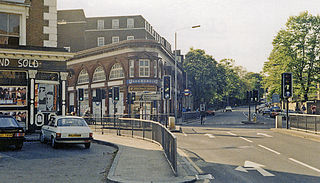
Chalk Farm is a small urban district of north London, lying immediately north of Camden Town, in the London Borough of Camden.
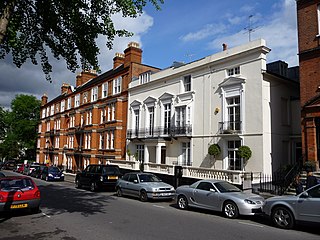
Hampstead is an area in London, which lies 4 miles (6.4 km) northwest of Charing Cross, and extends from the A5 road to Hampstead Heath, a large, hilly expanse of parkland. The area forms the northwest part of the London Borough of Camden, a borough in Inner London which for the purposes of the London Plan is designated as part of Central London.

Highgate is a suburban area of north London at the northeastern corner of Hampstead Heath, 4.5 miles (7.2 km) north-northwest of Charing Cross.

Samuel Augustus Barnett was a Church of England cleric and social reformer who was particularly associated with the establishment of the first university settlement, Toynbee Hall, in east London in 1884. He is often referred to as Canon Barnett, having served as Canon of Westminster Abbey from 1906 until death.

Hampstead Heath is a large, ancient London heath, covering 320 hectares. This grassy public space sits astride a sandy ridge, one of the highest points in London, running from Hampstead to Highgate, which rests on a band of London Clay. The heath is rambling and hilly, embracing ponds, recent and ancient woodlands, a lido, playgrounds, and a training track, and it adjoins the former stately home of Kenwood House and its estate. The south-east part of the heath is Parliament Hill, from which the view over London is protected by law.

Primrose Hill is a Grade II listed public park located north of Regent's Park in London, England, first opened to the public in 1842. It was named after the 64 metres (210 ft) natural hill in the centre of the park, the second highest natural point in the London Borough of Camden. The hill summit has a clear view of central London, as well as Hampstead and Belsize Park to the north and is adorned by an engraved quotation from William Blake. Based on the popularity of the park, the surrounding district and electoral ward were named Primrose Hill.

Gospel Oak is an inner urban area of north west London in the London Borough of Camden at the very south of Hampstead Heath. The neighbourhood is positioned between Hampstead to the north-west, Dartmouth Park to the north-east, Kentish Town to the south-east, and Belsize Park to the south-west. Gospel Oak lies across the NW5 and NW3 postcodes and is served by Gospel Oak station on the London Overground. The North London Suburb, Gospel Oak, has many schools around it.

Swiss Cottage is an area of Hampstead in the London Borough of Camden, England. It is centred on the junction of Avenue Road and Finchley Road and includes Swiss Cottage tube station. Swiss Cottage lies 3.25 miles (5.23 km) north-northwest of Charing Cross. The area was named after a public house in the centre of it, known as "Ye Olde Swiss Cottage".

John Linnell was an English engraver, and portrait and landscape painter. He was a naturalist and a rival to the artist John Constable. He had a taste for Northern European art of the Renaissance, particularly Albrecht Dürer. He also associated with the amateur artist Edward Thomas Daniell, and with William Blake, to whom he introduced the painter and writer Samuel Palmer and others of the Ancients.

Dame Henrietta Octavia Weston Barnett, DBE was an English social reformer, educationist, and author. She and her husband, Samuel Augustus Barnett, founded the first "University Settlement" at Toynbee Hall in 1884. They also worked to establish the model Hampstead Garden Suburb in the early 20th century.
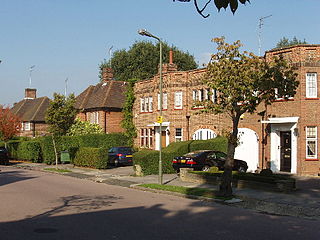
Hampstead Garden Suburb is an elevated suburb of London, north of Hampstead, west of Highgate and east of Golders Green. It is known for its intellectual, liberal, artistic, musical and literary associations. It is an example of early twentieth-century domestic architecture and town planning in the London Borough of Barnet, northwest London.

Belsize Park is a residential area of Hampstead in the London Borough of Camden, England.
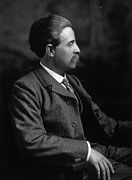
Sir Raymond Unwin was a prominent and influential English engineer, architect and town planner, with an emphasis on improvements in working class housing.
Charlotte Mary Wilson was an English Fabian and anarchist who co-founded Freedom newspaper in 1886 with Peter Kropotkin, and edited, published, and largely financed it during its first decade. She remained editor of Freedom until 1895.
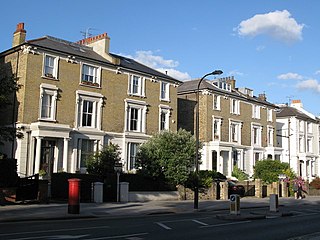
Haverstock is an area of the London Borough of Camden: specifically the east of Belsize Park, north of Chalk Farm and west of Kentish Town. It is centred on Queens Crescent and Malden Road. Gospel Oak is to the north, Camden Town to the south.

The London Borough of Camden is a London borough in Inner London, and historically a part of Middlesex. Camden Town Hall, on Euston Road, lies 1.4 mi (2.3 km) north of Charing Cross.
John Carrick Stuart Soutar was a Scottish-born architect, and is particularly associated with the design of buildings in Hampstead Garden Suburb in north London.

Romford Garden Suburb is a late-Edwardian housing development in Gidea Park, in the London Borough of Havering. The object of the new suburb, which was built on land belonging to Gidea Hall, then occupied by the Liberal politician Herbert Raphael, was, according to his parliamentary colleague John Burns, to "provide families with a well-built, modern home regardless of class or status" and "to bring the towns into the country and the country into the towns".

George William Potter was a builder, estate agent and surveyor in Hampstead, London, whose firm contributed to the modern development of Hampstead and Hampstead Garden Suburb. As a builder, he constructed the houses in Gayton Crescent and Gayton Road. Late in life he wrote two books of recollections of the history of Hampstead.